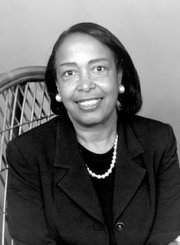Commending the Ingenuity of Black Female Inventors
The Chicago Citizen culminates its monthlong feature of African American inventors by paying homage to two innovative Black female inventors.
Madame C.J. Walker is credited for revolutionizing Black hair care, but her protg Marjorie Stewart Joyner also made significant strides in the cosmetology field.
During the 1920s, Joyner created a device that allowed women to straighten their hair by wearing a drying hood with rods attached inside connected to an electric cord. The Permanent Waving Machine was an instant success. Women were able to wear the hood for an allotted amount of time, resulting in a straight or curly hairstyle. This process was extremely painful so Joyner created a scalp protector to eliminate discomfort during the beauty method.
In 1928, Joyner received the patent for the machine making her the first African American female to do so.
Her machine allowed for hairstyles to last longer opposed to just one day with a conventional curling iron. In 1945, she co-founded the United Beauty School Owners and Teachers Association with Mary McLeod Bethune. Joyner also founded the Alpha Chi Pi Omega Sorority and Fraternity to serve as a coalition for beauticians.
Joyner also earned a bachelors degree in psychology at age 77from Bethune-Cookman College in a Daytona Beach, Fla. She died in 1994 at 98.
In 1986, Patricia Bath, M.D. developed a technique that broke new ground in the eye care field. She invented the laserphaco, a device used to surgically remove cataracts.
The idea for the device first came to Bath in 1981. It took her nearly five years to refine the model, complete research and apply for a patent. Baths hard work paid off and today the laserphaco is used worldwide.
Born in 1942, Bath has had a lifelong passion for medicine, especially ophthalmology. She earned a medical degree from Howard University College of Medicine and completed a fellowship at Columbia University.
Beyond her laserphaco creation, Baths career consists of many firsts.
In 1974, she was the first female ophthalmologist appointed to the faculty of the University of California at Los Angeles School of Medicine Jules Stein Eye Institute. Also in 1983, Bath was the first woman to chair an ophthalmology residency program in the United States.
Bath retired in 1993 from theUCLA Medical Center and was appointed to the honorary medical staff.
The ophthalmologist faced challenges on her journey to her successful career. Her mother scrubbed floors so Bath could attend medical school. Despite the hardship, Bath did not let her gender, race or socioeconomic status prohibit her from achieving her goals.
Sexism, racism and relative poverty were the obstacles which I faced as a young girl growing up in Harlem. There were no women physicians I knew of and surgery was a male-dominated profession. No high schools existed in Harlem, a predominantly black community; additionally, Blacks were excluded from numerous medical schools and medical societies. And my family did not possess the funds to send me to medical school, Bath previously said.
Sources: blackinventor.com, National Library of Medicine
by Thelma Sardin
Latest Stories
- Reminder: Taxes are due December 15, 2025. Pay now to avoid late fees. Struggling financially? Our Payment Plan Calculator is a tool you can use
- TWO GOVERNMENTS TO FORMALIZE HISTORIC PARTNERSHIP IN ADDRESSING MENTAL HEALTH CRISIS DURING THE HOLIDAY SEASON
- Trump's Policies Negatively Target Women
- Assessor Kaegi, South and West Side Community Leaders Urge Legislature to Pass Property Tax Relief, Condemn Board of Review's Large Breaks for Downtown Commercial Properties
- State Farm and The Salvation Army Launch National Donation Drive to Support Families This Holiday Season
Latest Podcast
Stacy Davis Gates



